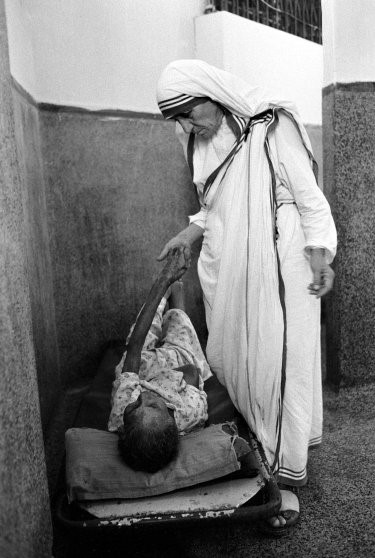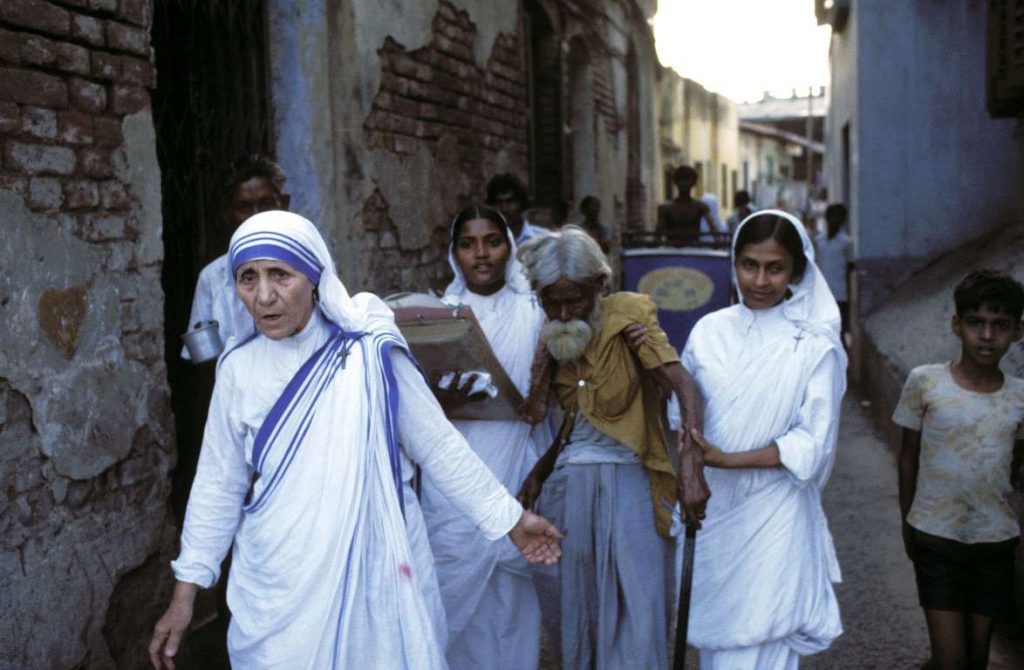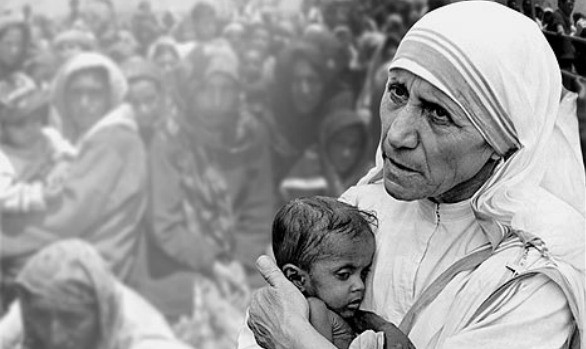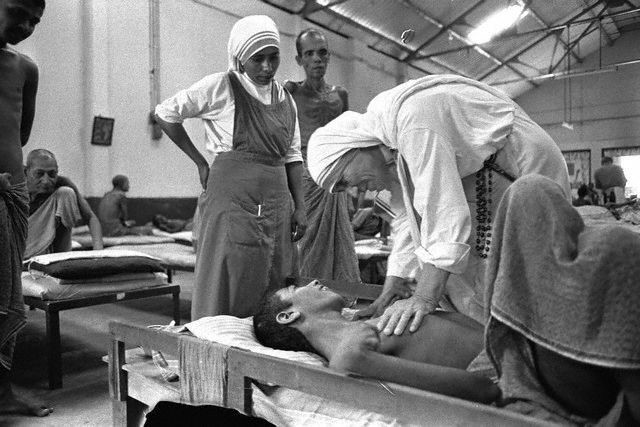Here are some pictures that profoundly impacted the world and touched people’s souls in the 1970s. St. Teresa of Calcutta (Mother Teresa) showed us that every person has dignity and is made in the image and likeness of God, whether it’s a little baby who is cute and adorable but starving, or the man who’s poor, begging, and emaciated.
Here’s a picture that was always hard for me to look at:
This man has no right arm below the elbow; he’s skin and bones. Look at the men behind him: They’re starving and emaciated. This is reality, the reality of human suffering: people don’t get the help they need and don’t have the basic necessities of life. We should look at the photo intently…. We tend to forget about this kind of suffering. Our culture is obsessed with pleasure and is materialistic, and so our concern for those in need is an add-on, something on the side, but not a regular, essential part of our lives.
Those in need are in our community—do we see them? Are they a part of our lives? St. John Paul II, at the beginning of the new millennium, wrote, “How can it be that even today there are still people dying of hunger? Condemned to illiteracy? Lacking the most basic medical care? Without a roof over their heads?” (Novo Millennio Ineunte, 50).
These photos impacted people for two reasons:
1) Jesus is present in the poor. We know theologically that every person bears the image of God, but we forget that Jesus says, “I was hungry and you gave me food, I was thirsty and you gave me something to drink, I was a stranger and you welcomed me, I was naked and you gave me clothing, I was sick and you took care of me, I was in prison and you visited me… Truly I tell you, just as you did it to one of the least of these who are members of my family, you did it to me” (Mt 25:35-36). When we look at these photos, we instinctively say, “Yes, St. Teresa was serving Jesus. She saw Him in the poor.” She called it Jesus’ distressing disguise in the poor. She said, “I see the face of Jesus in the poor, and I do it for Him.”
2) These photos show us that it was Jesus who was loving the poor through St. Teresa. The parable of the Good Samaritan (Lk 10:30-37), about the man who risked his own life to help a stranger who was beaten and robbed, was a story about Jesus’ love, and St. Teresa loved like the Good Samaritan.
These are the two truths we want to meditate on today: Jesus is in the poor, and those who love the poor, love like Jesus. This is very important, for Jesus teaches that we enter heaven or hell based on how we have loved Him in the poor. He says to those who love Him in the needy, “Come, you that are blessed by my Father, inherit the kingdom prepared for you from the foundation of the world” (Mt 25:34). But to those who saw Him hungry, thirsty, a stranger, naked, sick, in prison and didn’t love Him, He says, “You that are accursed, depart from me into the eternal fire prepared for the devil and his angels” (Mt 25:41).
Our mission here is to make disciples for Christ and lead them to heaven. To be a disciple means to love the poor, the sick, and the stranger like Jesus. So let’s consider some ways to love like Jesus, because I think we often get paralyzed in action because we don’t know what to do.
1) We mentioned two years ago how a parish in financial hardship felt called by God to give ten percent of its collection to those in need. God was saying to them, “You have great needs, but there are those in greater need. Will you help them even when you don’t have enough for yourselves?” When the pastor hesitated about doing this, a priest-friend said to him, “It seems you trust your money more than you trust God.”
This has been on my heart for the past two years, and this past September, while meditating on what St. John Chrysostom said to his people:
“Do you want to honour Christ’s body? Then do not scorn him in his nakedness.”
I was convicted that I haven’t done enough to lead this church to help the needy.
This is what I’m proposing: Of the money we give in the collection, can we donate ten percent of it to different needy causes, like pro-life groups, who work to save the defenseless, to people who work directly with the poor, to groups that help the needy locally and abroad?
We wouldn’t do it rashly or blindly, but I, along with the Leadership Team and the Finance Council would discern which groups are actually making an impact, which groups are following Church teaching with respect to those in need, and which are helping those in greatest need. We wouldn’t do it all at once, because we want to be very prayerful about this and discern God’s will, not ours.
This also wouldn’t mean an increase in what we’re giving and wouldn’t affect Project Advance or the Parish Centre fundraising. It would mean rather that our parish now considers giving to the needy as an essential part of who we are. As disciples, we would now know that ten percent of what we give goes to the needy and outside of ourselves.
In your pews, there’s a card you can fill out, by answering the question, “Should ten percent of our giving go to those in need? Yes. No. Unsure.” And there’s room for comments. Don’t fill them out now, but ask the Holy Spirit for guidance: Is this what the Father wants? Is this where our money should be going? Is this money well spent?
2) In line with this, could our parish do some works of mercy? Lisa Ward, one of our parishioners, has offered to coordinate works of mercy (like visiting the sick in hospitals, at home, driving people to Mass, helping the poor at various shelters, and helping those struggling with mental illness), and we’re wondering if people feel called by God to help. If we can arrange it and train people, would you want to serve?
On the back of those same cards, you can fill out if you’d be willing to help out in any way. You can write your name, phone number and email, and how often you may be free to help (E.g. weekly, monthly, annually). If you have any suggestions as to what needs there are and what we can do to help, please write them down and Lisa will contact you about them.
These two suggestions are relatively simple and won’t affect us immediately, so here are two others that we can put into practice soon.
3) For Christmas, can we only buy gifts that people need? Twice this year, we’ve talked about only buying necessities during Lent and there was an audible reaction! If people don’t need something, why buy it for them? What about the poor? Couldn’t we use the money for them? If doing this is too challenging, then what about buying less this Christmas? Why not spend half on buying things that people want, and half on people in need?
Giving and receiving gifts is an authentic way we show love; it’s a love language, a way to show we care and appreciate someone, and it’s fun to find the perfect gift, so we don’t have to cut it out completely. What God is asking us to do is to become less materialistic, to teach our children that getting what we want for Christmas won’t make us really happy, to teach them to be mindful of the less fortunate, to discipline our spending, and to be generous.
4) Jesus mentions today welcoming the stranger as part of the ways we’ll be judged. We’ve all grown in hospitality and openness as a Catholic family—praise God and thank you—but, for a few weekends during Advent, and then on Christmas day, we’d like to suggest that, just before Mass starts, we quietly introduce ourselves to one person sitting around us whom we don’t know and pray for that person. This will be very helpful in fostering a welcoming spirit on Christmas day when we’ll have lots of non-practicing Catholics and we want to love them. And we still have so many people who come here anonymously and are treated like strangers.
But, if we do this, we don’t want to lose our reverence! We need to respect God’s house. With His help and by acting virtuously, we can be silent, then greet each other with warmth, and then go back to silence—that’s what virtuous Catholics can do; we can do both well.
It’s interesting: We tend to think that welcoming a stranger isn’t that important, yet Jesus has it on His list of ways we do or do not love Him.
The centre of Mother Teresa’s life was not the poor. They were an important part of her life, but Jesus was the centre. She spent hours a day listening and speaking to Him, praying the Rosary, and receiving the Eucharist daily. This is where she drew her love from.
This is where we draw our love from too. When we encounter Jesus in His Word and in the Eucharist, He fills us with love, and so these four suggestions will come naturally:
1) Our parish spending ten percent on the needy.
2) Doing some works of mercy.
3) Spending money better this Christmas.
4) Welcoming the stranger.
Jesus is in the poor, and those who love them love like Jesus.




